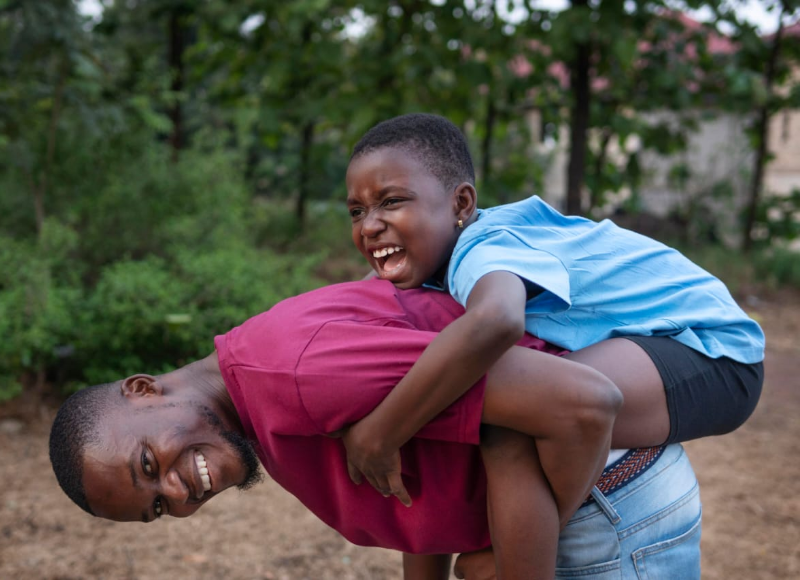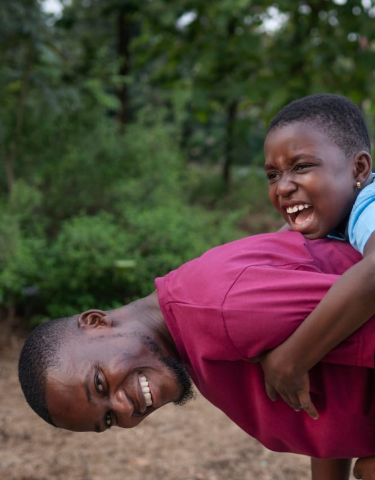Introduction: The Scale of the Challenge
Father absence is not new, but in South Africa its prevalence and persistence constitute a serious social risk. According to the State of South Africa’s Fathers (SOSAF) 2024 report, only 35.6 % of South African children live with their biological fathers in the same household, while 40.3 % live with a man who is not their biological father (for example, extended family, stepfathers, or mother’s partners).
More strikingly, a recent survey (General Household Survey) finds that 64.5 % of children do not live with their biological fathers, making non-residence more the norm than exception.
Historically, the legacies of apartheid, labor migration, economic inequality, and cultural shifts have all contributed to paternal absence. The challenge now is understanding the risks this poses — for children’s wellbeing, social cohesion, and national development — and charting realistic interventions to mitigate them.
This article adopts a risk framework: it identifies the vulnerabilities and cascading harms, maps proximate and structural drivers, and proposes interventions by state, civil society, and communities to reduce the risks of father absence escalating into systemic dysfunction.
The Risks and Consequences of Father Absence
Father absence (or non-residence) is not a monolithic problem — its impacts vary by context, age, gender, and presence of alternative caregivers. Still, several recurring risk domains emerge.
1. Emotional Risks, Psychological Risks, and Identity Risks
- Emotional void & loss
Qualitative studies of South African youth show that many adolescents and young men articulate emotional pain, abandonment, or longing in relation to their absent biological fathers. Some describe self-isolation, withdrawal, or turning to anger or aggression as coping mechanisms.
- Identity & Masculinity crisis
In a cultural context where fatherhood is tied to masculine identity and heritage, absence of the father can disrupt connection to paternal lineage, rites, or masculine role modeling. Some young men report feeling disconnected from their “paternal heritage,” contributing to a fractured sense of self.
- Mental health vulnerabilities
The gap of emotional support, role modeling, and oversight can magnify the emotional risks of depression, low self-esteem, substance abuse, and behavioral problems. Studies link father absence with higher rates of externalizing behavior, early substance use, and emotional distress.
- Attachment & relational difficulties
Children who lack a stable male caregiver may struggle with forming trust, maintaining relationships, or navigating conflict. This can affect peer relationships and adult partnerships later on.
2. Economic and Material Risks
- Resource constraint & single parent burden
In households where mothers bear the bulk of caregiving and provision, economic strain often intensifies. Maternal overwork, underemployment, or multiple jobs can limit the time and resources available to children.
- Educational underachievement
Children without engaged fathers tend to show lower school performance, higher dropout rates, and weaker educational aspirations. The presence of an involved father is associated with better grades, higher motivation, and support in schooling.
- Intergenerational poverty
The compounded effect of diminished human capital (education, social networks) and economic hardship can entrench poverty across generations. In communities already struggling, father absence magnifies the risk that a child remains economically marginalized.
3. Behavioral and Social Risks
- Risky behaviors & early sexual debut
In contexts where supervision, role modeling, or guidance are missing, children (especially adolescents) may engage in substance use, risky sexual behavior, or delinquency. Research in South Africa links father absence with early sexual initiation, unprotected sex, and teenage pregnancy.
- Violence, crime, and social instability
Some civil society narratives and correlational studies in South Africa associate high rates of father absence with elevated levels of crime, gangsterism, and social disorder. While causality is complex, lack of stable male mentorship and supervision in communities increases the risk of youth being drawn into anti-social networks.
- Gender-based violence & skewed gender norms
The absence of positive paternal role modeling may worsen destructive masculinities, perpetuating norms of dominance, aggression, or lack of emotional expressiveness. Some argue that father absence contributes to intergenerational cycles of violence and toxic norms around masculinity.
4. Institutional and Societal Risks
- Weakening social capital and community cohesion
Families serve as basic social institutions. Widespread father absence can erode social networks, mentoring channels, and community surveillance. This can weaken trust, civic engagement, and communal responsibility.
- Strain on social services
Increased demand for social welfare, counseling, child protection, and youth rehabilitation services arises when children face the vulnerabilities above. Over time, state resources may become overwhelmed.
- Cultural dislocation & normative erosion
When father absence becomes normalized, societal expectations and norms around parental roles shift, potentially diminishing accountability and enforcement of paternal responsibility (financial, social, emotional).
Drivers and Root Causes: Why So Many Fathers Are Absent
To design effective remedies, one must understand what drives father absence in South Africa. Key factors include:
1.Historical and Structural Legacies
- Apartheid-era labor migration
Under apartheid, Black men were often forced to leave their families to work in distant mines or urban centres, spending long periods away from home. This pattern became deeply institutionalised, fragmenting families and setting precedents for long-distance parenting dynamics.
- Economic inequality & unemployment
High unemployment, especially among Black men, makes fulfilling the provider role difficult. Some men avoid engagement due to shame or inability to contribute materially.
- Housing, land, and spatial fragmentation
Informal settlements, migration for work, and housing scarcity mean families often cannot stay together in stable residences. Men may live elsewhere for opportunity or due to housing constraints.
- HIV/AIDS pandemic and mortality
The HIV epidemic has resulted in many children losing fathers to disease, reducing possibilities for paternal presence even when desired.
2.Cultural Norms, Masculinity, and Gender Roles
- Provider-centric masculinity
In many communities, fatherhood is equated with financial provision more than caregiving, leaving men feeling they fail when unable to provide. This reduces their perceived legitimacy in participating in everyday care.
- Stigma of vulnerability & emotional expression
Cultural norms often discourage men from emotional intimacy or vulnerability, making sustained father–child relationships more difficult. Some men resist involvement because it clashes with ideals of stoicism or strength.
- Absence of social father role recognition
Even when alternative male figures (uncles, grandfathers, mentors) step in, social norms may undervalue or under-support these roles. The idea that only biological fathers “count” undermines broader caregiving possibilities.
3.Legal, Institutional, and Policy Gaps
- Weak enforcement of maintenance obligations
Though South Africa has legal mechanisms (child support orders) to require noncustodial parents to contribute financially, enforcement is often weak, and many fathers evade or default.
- Fragmented family policy
There is often a lack of integrated policy linking social welfare, fatherhood programmes, gender equality, and community development.
- Inadequate men-focused services
Parenting and family support services historically have targeted mothers; men often lack accessible spaces or programs to support their fathering roles.
4.Family Dynamics and Relationship Breakdown
- High rates of nonmarital births, relationship instability, and union dissolution
Without stable relationships or marriage, father–child links may not be institutionalised or maintained over time.
- Maternal gatekeeping or conflict
In some cases, conflict between parents, trust breakdowns, or maternal remarriage can limit paternal involvement or access.
- Lack of father–child bonding in early years
When bonds are weak in early childhood, it becomes harder to sustain involvement later, especially amid distance or disruption.
A Risk-Mitigation Framework: What South Africa Can Do
Given the scale and complexity of father absence, responses must operate on multiple fronts: prevention, remediation, institutional reinforcement, and cultural change. Below is a strategic blueprint to ensure family resilience.
1.Early Intervention & Prevention
- Pre- and Peri-natal engagement programs
Healthcare settings (antenatal clinics, clinics) can invite expectant fathers to counselling, co-parenting education, and bonding sessions. Building father–child ties before birth increases later involvement.
- Parenting education for young men
Integrate fatherhood modules into youth development and life-skills training to reshape masculine identities toward involved caregiving.
- Support for father–daughter/son bonding
Sponsorship of father–child events, mentorship programs, and bonding activities encourages men (biological or social) to invest time and presence.
2.Strengthening Legal & Policy Instruments
- Reform and enforce maintenance / child support systems
Bolster mechanisms to track, enforce, and sanction non-payment of child support. Consider linking incentives (e.g. tax credits, benefits) to compliance.
- Mandatory parenting plans in family law
When parental separation occurs, court orders should require structured parenting time and visitation schedules rather than presuming non-engagement.
- Psychological impact assessments in custody decisions
Courts should evaluate emotional needs of children and consider father involvement capacity when making custody or guardianship rulings.
- Fathers’ rights in adoption/guardianship law
Ghana’s Fraser v Children’s Court decision in South Africa affirmed that in adoption of children born out of wedlock, a father’s consent is sometimes required. Such legal recognition should be more widely supported and enforced.
3.Institutional Support and Programme Infrastructure
- Fatherhood support centers / hubs
Community and municipal-level fatherhood resource centers can provide counseling, peer support, parenting classes, legal advice, and skill development.
- Collaboration across agencies
Ministries of Social Development, Education, Health, and Justice should coordinate fatherhood programming, with shared budgets and data systems.
- Incorporate father-inclusive design in social services
Clinics, schools, child welfare services should explicitly include fathers in outreach, communications, and scheduling, not assuming mothers as default caregivers.
- Incentive schemes for engaging fathers
For example, conditional grants or benefits (e.g. increased social grants) could reward consistent father engagement (attendance at school meetings, parenting classes) — akin to conditional cash transfers.
4.Leveraging Social Fathers, Mentors & Community Networks
- Support for social fathers / male mentors
Recognize and resource the role of alternative father figures (uncles, grandfathers, coaches, community leaders). Their involvement helps buffer the risks of absent biological fathers. SOSAF emphasizes the importance of “positive care by any man.”
- Mentorship programs in schools and communities
Deploy male mentors in schooling and youth development to provide continuity, psychosocial support, guidance, and role modeling.
- Group-based healing and father forums
Spaces where men gather to reflect, share fatherhood challenges, and culturally reimagine masculinity can help shift norms and re-anchor committed fathering.
5.Cultural & Normative Change Campaigns
- National campaigns on engaged fatherhood
Media, social media, and public journalism should elevate stories of present fathers, father–child bonding, and challenge stereotypes around masculinity.
- Educational curricula integration
Schools should teach youth about gender equality, parenting roles, and emotional literacy, reducing gendered division of caregiving from early years.
- Churches, traditional leaders, and cultural forums
Engage faith-based institutions and tribal structures to promote messages about responsible fathering, reconciliation, and community accountability.
- Sports, arts, and youth outreach platforms
Use sports heroes, artists, and influencers as champions of involved fathering, showcasing positive father–child relationships.
Monitoring, Evaluation & Research
- Father involvement metrics
Standardise metrics for paternal presence beyond co-residence (e.g. time spent, emotional support, financial support) and embed them in national household surveys.
- Risk mapping and early warning systems
Identify communities with high father absence, low male employment, or youth behavioral crises as priority areas for targeted intervention.
- Rigorous evaluation of fatherhood programmes
Track outcomes (child mental health, educational attainment, delinquency, father behavior) to refine and scale only what works.
- Participatory research with youth voices
Incorporate the perspectives of children and young people who have lived the experience of father absence to inform programme design and policy.
Risk Identification and Assessment as per priority
Because resources are constrained, it is essential to prioritize interventions by risk severity, scale, cost-effectiveness, and feasibility. Below is a summary:
| Risk Domain | Severity / Urgency | Leverage Point for Intervention | Priority Action |
|---|---|---|---|
| Early emotional trauma & identity disruption | High | Intervene in early childhood (0–5) and adolescence | Prenatal engagement + father–child bonding programs |
| Educational underperformance and dropout | High | School-based father inclusion and mentoring | Father-inclusive policies in schools, mentorship |
| Family economic strain | Medium–High | Strengthen child support enforcement + livelihood support for fathers | Maintenance system reform, incentives |
| Youth delinquency / crime risk | High in hotspot areas | Community mentorship + social father deployment | Invest in youth outreach, mentorship hubs |
| Normative erosion (masculine norms) | Long-term but cumulative | National campaigns + cultural engagement | Media, faith-based advocacy, father forums |
By focusing first on early-life and educational leverage points, South Africa can interrupt negative trajectories before they cascade into deeper social dysfunction.
Potential Risks, Resistance & Mitigation
Implementing these interventions entails risks and potential backlash; anticipating them is crucial.
- Resistance from men feeling blame or shame
If policies are perceived as coercive or accusatory, men may withdraw further. Mitigation: frame interventions as support rather than blame; involve men in co-design.
- Stigmatisation of single mothers or children
Caution must be taken not to blame mothers or stigmatize children for lacking fathers. Messaging should reinforce dignity and shared responsibility.
- Policy fragmentation / inter-departmental turf wars
Ministries may compete rather than collaborate. Mitigation: high-level coordinating bodies and shared accountability.
- Resource constraints & sustainability
Fatherhood programmes may suffer from underfunding. Prioritize scalable, low-cost models (peer support, volunteer mentors) and integrate into existing institutions (schools, clinics).
- Cultural backlash to changing gender roles
Some communities may resist shifts in masculine norms or father caregiving roles. Mitigation: engage traditional leaders, faith institutions, and grassroots dialogues to legitimate new norms.
- Program tokenism
Superficial “fatherhood days” or campaigns without structural backing will fail. Programs must link symbolic efforts to sustained infrastructures (support centers, monitoring systems, enforcement).
Conclusion: Toward a South Africa with Caring Fatherhood
Father absence in South Africa is not simply a personal or family issue — it is a structural risk that threatens education, mental health, social cohesion, and intergenerational mobility. The statistics are sobering: only about one in three children lives with their biological father, and two out of three do not.
But this need not be destiny. A risk-based approach guides us to focus on leverage points: infancy and early bonding, child development, school systems, community mentorship, legal accountability, and culture change. If state institutions, civil society, and communities act in concert — not as separate silos but as integrated systems — it is possible to reverse the trend.
The imperative is not to shame men, but to support them; not to blame mothers, but to relieve them of impossible burdens; not to romanticize ideal families, but to enable stable, caring, responsible fathering in its many forms. The concept of fatherhood itself must expand: biological, social, spiritual, communal — all valid when grounded in care, presence, and accountability.
The risk is high, but so is the opportunity. South Africa stands at a crossroads: continue allowing father absence to become normalized — and risk deeper social fracture — or commit to rebuilding the relational infrastructure that undergirds healthy children, families, and communities.















